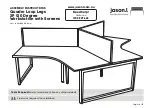
73
73
Section 7: Solving Problems
Problem
Solution
Slide is covered with hematoxylin
precipitate and nucleus is red.
Check the Reagent C (bluing) reservoir level or check
nozzle ABCE for plugging. If bluing is not delivered in
sufficient quantities, proper bluing of nucleus and removal
of hematoxylin is not possible. Therefore, when the alcohol
is atomized onto the slide the hematoxylin precipitates.
Since the alcohol has no buffering capacity, the nucleus
does not blue properly, and the nucleus remains red.
Nuclear and cytoplasmic staining
is not sharp or crisp.
Good nuclear and cytoplasmic staining requires proper
fixation and the complete removal of all water from the cells
(clearing) prior to coverslipping. Alcohols tend to absorb
water from the atmosphere. If cells are not sharp and crisp,
replace the Reagent E (alcohol wash) with a fresh supply.
Then flush the line with 100 mL of fresh reagent. If this
does not work, place slides in fresh anhydrous alcohol
(or reagent E alcohol wash), followed by xylene or xylene
substitute (1 minute each) prior to coverslipping.
Xylene replaces the alcohol (which absorbs
water) with a medium that does not.
Cloudiness appears upon coverslipping.
Xylene and xylene substitutes are not miscible with water, excess
water on the slide produces a milky haze over the slide. Endspin
can be increased to reduce some cloudiness due to excess water.
Replace Reagent E (alcohol wash) with fresh stock and flush
line with at least 100 mL. Remove coverslip and mounting media
from the slide using xylene or xylene substitute and dehydrate
in 100% ethanol, then recoverslip. In areas of high humidity,
dip slides in Reagent E for one minute, then xylene or xylene
substitute for one minute, then coverslip. In high humidity
environments xylene preforms better than xylene substitutes.
Cornflaking artifacts.
Never allow slide surfaces to dry at any time during the
staining procedure, including the time prior to coverslipping.
If slides are not quickly coverslipped or kept immersed in
Reagent E or xylene, cornflaking artifacts may appear. If
cornflaking obscures nuclear detail, remove as follows; soak
slide in xylene or xylene substitute to remove coverslip. Soak
uncoverslipped slide in xylene for 10 to 60 minutes to remove
mounting media, then in Reagent E (alcohol wash) for 10 to 60
minutes or until cornflaking disappears. Coverslip the slide.
Microscopic bubbles appear after coverslipping. To avoid microscopic air bubbles in mounting media, do
not use mountant for 16 hours after refilling decanter.
Cell loss.
The following conditions will enhance cell adhesion:
Use treated slides such as poly-L-lysine. Use spray fixation
in place of fixation by immersion in 95% alcohol. Use lower
stain intensity settings. Use fresh, unfixed, room-temperature
body fluids for cytocentrifugation. Use no Pre-Wash option.
High levels of precipitates observed.
Discard leftover stain in the used bottle when changing
to a fresh bottle of stain. While transferring remaining
stain saves stain, it eventually concentrates the
precipitates to the point they appear on the slide.
















































